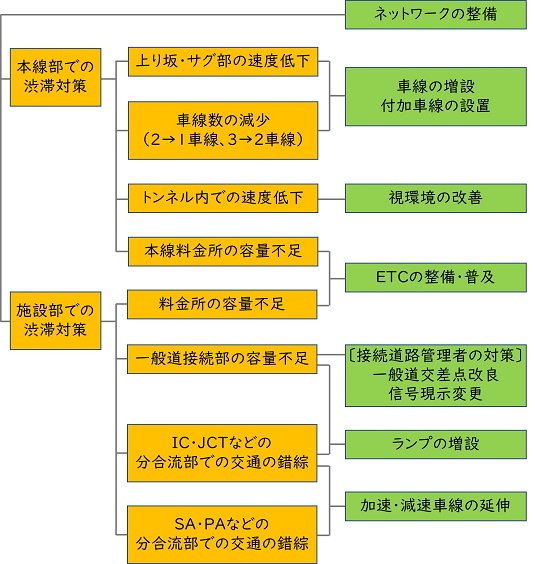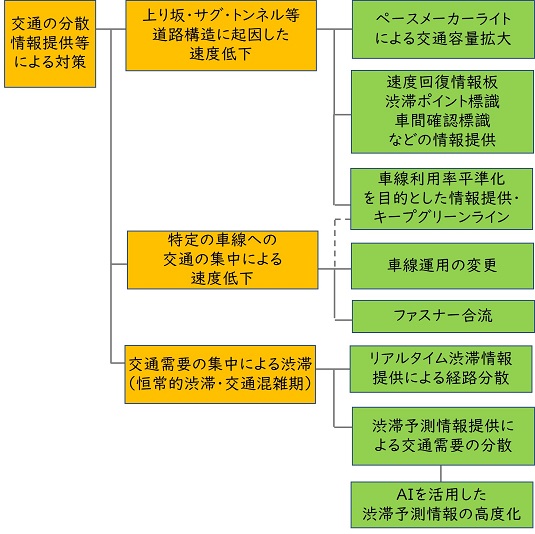高速道路の渋滞対策
渋滞の原因を分析し、渋滞解消・緩和対策を実施しています
渋滞発生状況の推移
高速道路における渋滞損失時間※1は、1997年をピークに減少傾向が続き、2008年にはピーク時の5割程度まで減少しました。
その後、2009年以降の休日特別割引(地方部5割引・上限1,000円等)による増加を経て、2014年以降は各種渋滞対策効果の発現により減少傾向が続いていましたが、2017年以降、首都圏近郊のネットワーク整備に伴い当社管内の交通量が増加し、渋滞損失時間は再び増加しました。
2020年は新型コロナウィルス感染症の影響等により大きく減少しましたが、コロナ禍の収束に伴い徐々に増加傾向にあります。

- 渋滞の度合いを表す指標。渋滞によるロス時間と影響を受けた台数の積により算出します。
- 1997年は民営化前のピーク(NEXCO東日本管内)
- 「その他」には、故障車や落下物の影響による渋滞や、対向車線の事故による見物渋滞などが含まれます
- 2021年は東京2020大会に伴う交通規制の影響で、例年よりも「その他」の割合が高くなっています
渋滞の発生原因と発生箇所
一年間に管内で発生する渋滞のうち約7割が交通集中によるものです。(2023年)
このうち渋滞発生箇所の内訳として、上り坂およびサグ部※5が約6割と大部分を占めています。
※5 下り坂から上り坂にさしかかる凹部をサグ部といいます。渋滞発生メカニズムや渋滞対策について、詳しくはこちら


【渋滞ポイントマップ】
NEXCO東日本管内の主な渋滞ポイントや渋滞の傾向を「渋滞ポイントマップ」にて掲載しています。渋滞回避にお役立てください。


【ETCの整備・普及】
交通集中渋滞のワースト1位であった料金所部での渋滞は、ETCの普及によりほぼ解消されました。

※6 民営化以前もNEXCO東日本管内の数値
※7 ETC2.0利用率はETC利用率の内数
渋滞緩和対策
お客さまに安全で円滑な道路交通を確保するため、ハード・ソフト両面の対策を実施し、渋滞緩和に努めてまいります。
-
ハード面の対策
-
ソフト面の対策
【付加車線の設置】【加速・減速車線の延伸】
主要な渋滞箇所において付加車線の設置、加速・減速車線の延伸などを行っています。
-
E17関越道(下り)花園IC出口車線の延伸状況
【E17】関越自動車道下り線 花園インターチェンジ付近で出口車線延伸の運用を開始いたします

【ペースメーカーライト(PML)による交通容量拡大】
光が進行方向に移動するように点滅させることで、速度低下抑制・速度回復支援に効果を発揮しています。
-
アクアライン(上り)アクアトンネル付近のPML運用状況

【渋滞ポイント標識等による速度回復情報提供】
主要な渋滞発生箇所に標識を設置し、意識的な速度回復を促しています。
- 渋滞ポイント標識の運用状況

- 速度回復表示板の運用状況

【車線運用の変更】
交通状況の変化に応じ、最適な車線運用へと改良を行っています。
-
E17関越道(上り)大泉JCTの車線運用変更状況

-
E17関越道(下り)東松山IC付近の車線キープグリーンライン
車線キープグリーンラインに沿ってキープレフトを続けていただくことで、追越車線への車両の集中や無理な車線変更が抑制され、渋滞や事故の軽減が期待できます。
また、ランプからの緑線に沿って走行すると自然と正しい方向で本線に合流できるため、逆走対策の効果も期待できます。
【渋滞予測情報の提供】
NEXCO東日本には、地域の特性を熟知した渋滞予測のプロである「渋滞予報士」がいます。
いつ、どこで、どのくらいの渋滞が発生するかを予測し、HPなどで提供しています。
渋滞緩和のため混雑する日にちや時間帯を避けた「分散利用」へのご協力をお願いいたします。


また、当社では、橋やトンネルなどの大規模なリニューアル工事を実施しています。こうした工事では、長期通行規制による影響を最小限にすべく工事短縮や通行規制方法の工夫に取り組んでいますが、重交通路線などではやむを得ず渋滞が発生する場合があります。
こうした渋滞を少しでも減らせるように、リニューアル工事等の長期規制を伴う工事による渋滞についても、単なる「予想」ではなく交通工学に基づく正確な「予測」を実施し、お客さまへ丁寧な情報発信を心掛けています。
健全な道路を次世代につなげるために、ご理解とご協力をお願いいたします。
【AIを活用した情報提供】
AIを活用した渋滞予測等の技術開発を推進しており、さらなる予測精度・利便性の向上に取り組んでいます。
-
AI渋滞予知
株式会社NTTドコモ(以下、ドコモ)が携帯電話ネットワークの仕組みを利用して作成するリアルタイム人口統計と、NEXCO東日本が保有する過去の渋滞実績や交通流に関する技術的知見等をかけ合わせ、ドコモが人工知能(AI)技術を用いて開発した「AI渋滞予知」により、一部路線において帰宅時間帯の渋滞を予測する実証実験を行っています。実験では、30分ごとの通過所要時間などの情報をNEXCO東日本のお客さま向けWEBサイト「ドラぷら」で配信しています。
関連プレスリリース
- NEXCO東日本とNTTドコモ、【CA】東京湾アクアラインにおいて「AI渋滞予知」による渋滞予測実証実験を開始
- 【CA】東京湾アクアラインの「AI渋滞予知」が30分ごとの通過所要時間提供へ
- 「AI渋滞予知」で【E17】関越自動車道の渋滞を予測!
- 『AI渋滞予知』2022年7月28日より【E14】京葉道路でも実証実験を開始
-
【E14】京葉道路で実証実験中の「AI渋滞予知」2023年12月13日リニューアル
(年末年始期間の高速道路における渋滞予測について【東日本版】別紙4)


渋滞を減らすためには、当社の取り組みはもちろんのこと、高速道路をご利用いただくお客さまのご協力が不可欠です。
1人でも多くのお客さまが、渋滞を知り、渋滞を減らすための「ちょっとした心がけ」を実践していただくことで、当社が行う渋滞対策の効果は何倍にもなります。
そんなお客さまとの「渋滞対策の掛け算」を高めていけるよう、NEXCO東日本ではこのロゴをキャッチコピーとしてこれからも渋滞対策を推進してまいります。
ご理解とご協力をお願いいたします。
渋滞緩和のためにお客さまに実践していただきたい「渋滞予防運転」の4箇条
- 無意識な速度低下に要注意!※8
上り坂やサグ部などでのわずかな速度低下が渋滞の原因となります。 - 車間距離を確保!
クッションの役割を果たし後続車にブレーキが伝わるのを防ぎます。 - むやみな車線変更を控える!
むやみな車線変更は、後続車にブレーキを踏ませ、渋滞を発生または悪化させる原因となります。 - 速やかな速度回復!(渋滞時)
道路情報板や渋滞ポイント標識などで渋滞の先頭位置をお知らせしています。
渋滞通過後は速やかな速度回復をお願いいたします。
※8 危険回避や安全確保のためのブレーキ使用を否定するものではありません。


